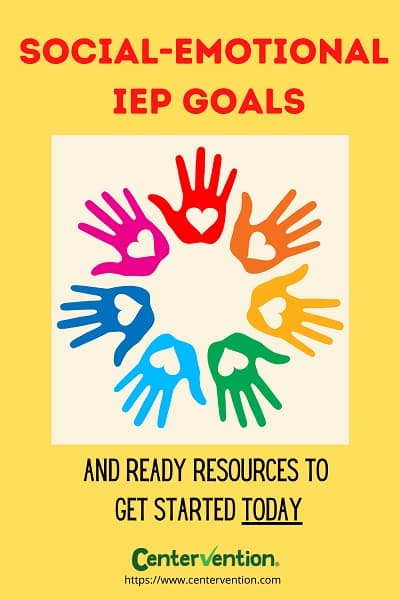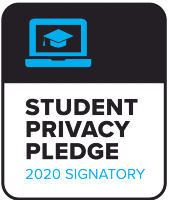What do Social Emotional IEP Goals Look Like?
Social Emotional Learning (SEL) is valuable for all students, and while a majority of students respond well to Tier 1 SEL lessons, others will benefit from the additional support of Social Emotional IEP goals written into behavioral plans.
IEP goals are typically generalized, leaving room for the educator to customize them. While you may draft an IEP from a standard menu of student goals, you will need to insert the individual’s name, and carefully consider the expected frequency for performing the goal (how often or with what percentage of accuracy the student demonstrates the objective) as well as the tool for measuring or observing performance (checklist, notes, activities, evaluations, etc.). Keep in mind that this will be different for each student based on his or her ability, and it may also be necessary to adjust the IEP goals when the evaluation period ends or the IEP is up for review or renewal.
As you develop IEP goals for social emotional learning, it’s important to remember that they must be achievable and measurable. When this is done well, a goal is often referred to as SMART: Specific, Measurable, Attainable, Results-oriented, and Time-bound. List clear expectations for what will qualify as successfully performing and achieving a specific goal and include activities that measure and demonstrate each specific objective.
Social Emotional IEP Goal Bank
We understand that you want to provide your students with the greatest possible chance for success in meeting their IEP goals. To help out, we’ve assembled a list of 10 frequently cited Social Emotional IEP goals as well as actionable objectives to include with them. Best of all, we’ve linked ready to go lessons and printables to each objective and provide additional resource suggestions to extend learning, giving you time to spend with your students instead of with their paperwork.
When you’re done writing, be sure to download our printable progress monitoring form to help keep your data organized.
Feelings Goals
___________ will identify and manage feelings(i.e., anger, anxiety, stress, frustration) with ___________ frequency as measured by ___________.
Actionable Objectives:
- Identifies the emotional response to a given situation
- Describes feelings or mood when prompted
- Practices calming strategies to regulate emotion
- Practices methods to reduce anxiety and stress
- Manages frustration appropriately
___________ will independently identify and express feelings with ___________ frequency, as measured by ___________.
Actionable Objectives:
- Recognizes and produces appropriate facial expressions for a variety of emotions
- Displays appropriate responses in given situations
Additional Support for Feelings Goals:
Looking for more ways to explore feelings with your students? Check out Zoo Academy, our game that provides students with many scenes that explore identifying, managing, and expressing their feelings, such as this one in the Feelings Garden:
Mr. Greene helps players and other students explore the garden, where unique flowers look like animals and people. Players will look at the different flowers’ facial expressions and body language and identify which emotions they portray. Players will also hear and view an animated song showing the physical symptoms that come with different emotions, like a flipping stomach for feeling scared or a hot face when angry.
Self Regulation IEP Goals
___________ will demonstrate self regulation with ___________ frequency as measured by ___________.
Actionable Objectives:
- Adapts effectively to change
- Uses strategies to manage emotions
- Maintains focus on assigned task
- Displays flexible thinking
Communication Goals
___________ will demonstrate appropriate verbal and nonverbal communication and conversation with ___________ frequency as measured by___________.
Actionable Objectives:
- Identifies appropriate topics for conversation
- Expresses feelings through nonverbal cues
- Correctly interprets nonverbal communication
- Practices appropriate tone of voice when communicating
- Maintains focus during conversation
- Demonstrates self control in conversations
Additional Support for Communication Goals:
If you’re looking for another fun and interactive experience for developing communication, your students will love using puppets in the virtual classrooms of Zoo U to practice tone, voice, and body language while exploring a range of emotions!
Responsibility Goals
___________ will control impulsive behavior with ___________ frequency as measured by ___________.
Actionable Objectives:
- Identifies impulsive and controlled behaviors
- Defines the differences between impulsive and controlled behavior
- Identifies the consequences of impulsive behavior
___________ will make appropriate decisions with ___________ frequency as measured by ___________.
Actionable Objectives:
- Takes a voluntary break to manage emotions
- Apologizes when actions injure/infringe upon others
- Describes possible consequences of decisions
- Reflects on behavior
Additional Support for Responsibility Goals:
Accepting responsibility can be hard, and Ellen Javernick’s What If Everybody Did That? gives students space to practice and reflect on the power of making good choices.
Peer Relationships Goals
___________ will demonstrate appropriate assertiveness and engagement in play and cooperative learning with peers with ___________frequency as measured by ___________.
Actionable Objectives:
- Initiate conversations with peers
- Expresses appreciation appropriately
- Expresses verbal support to peers
- Works with peers towards shared goal
- Identifies appropriate behavior when presented with situations involving peer pressure
- Seeks assistance to solve problems with peers when appropriate
- Seeks opportunities to engage with peers
___________ will engage in appropriate group discussions and activities with ___________ frequency as measured by ___________.
Actionable Objectives:
- Identifies positive social behaviors
- Listens respectfully to the opinions of others
- Makes positive statements about the qualities and accomplishments of others
- Respects physical boundaries of others
Additional Support for Peer Relationships Goals:
Making friends and maintaining positive peer relationships is at the heart of Social-Emotional Learning! Whether your students need extra help with joining in with the group or cooperating with friends, they’ll love making a personalized social story comic book with Centervention’s Stories in Motion series!
Conflict Management Goals
___________ will independently manage conflicts with ___________ frequency as measured by ___________.
Actionable Objectives:
- Identifies strategies for resolving conflicts
- Appropriately expresses feelings when conflict arises
- Cooperates with peers to resolve conflicts
- Listens to the opinion of a peer without interrupting or walking away
Additional Support for Conflict Management Goals:
Learning and using positive communication strategies is a process that lasts throughout schooling (and even into adulthood!). Let your students take a ride on the S.S. Grin or a walk through the Hall of Heroes to practice communication and problem solving in many exciting scenes!

